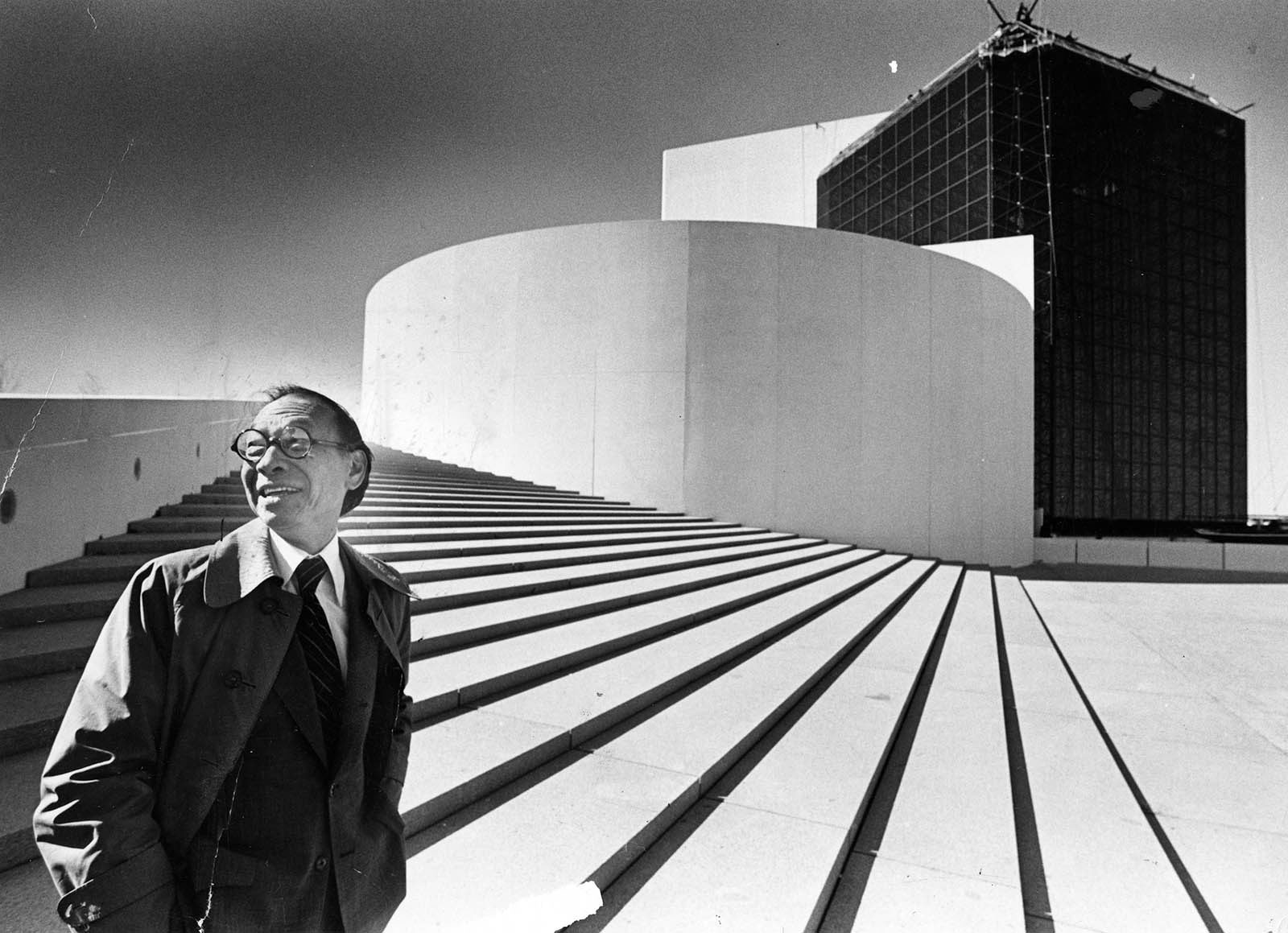Ieoh Ming (I.M.) Pei died on May 16, 2019, at the age of 102. Over six decades, the Pritzker Prize-winning architect developed an inimitable sensitivity to form, light, environment, and history that transcended the rationalism of his Bauhaus education. The ideas he pursued and refined throughout his celebrated career can be traced back to his time at Harvard’s Graduate School of Design.
Pei came to the GSD in 1942 to study with Bauhaus founder Walter Gropius and his protégé Marcel Breuer, and he stayed on after graduating in 1946 to teach for two years. His architecture thesis, a project that culminated his time as a student, was a design for a Chinese art museum for the city of Shanghai. It proposed a series of small galleries conjoined with gardens at a scale that evoked a sense of privacy traditional to Chinese art museums. But it also represented a thoroughly modern design and foretold a deepening interest in the interdependence of physical space, light, and environment—the built environment and the natural world.
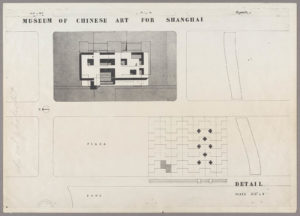
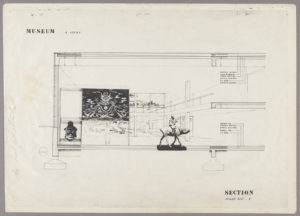
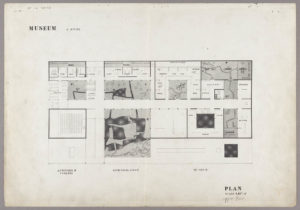
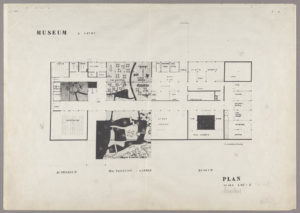 “It was at that moment that I said I would like to prove something to myself, that there is a limit to the internationalization of architecture,” said Pei of the project. “There are differences in the world, such as climate, history, culture, and life. All these things must play a part in the architectural expression.” In modernism, the measure of successful architecture could be somewhat absolute, eliding cultural, historical, and ethnographic concerns, which would return to the fore in the following decades. Designing a museum for Chinese art created an opportunity for Pei to test the limit of this “internationalization,” owing to the culture-specific differences in how art objects in China and the West were commissioned and shown. Western museums housed art objects intended to be on continual public display and required vast galleries and copious wall space. Chinese art museums, by contrast, housed art objects historically intended to be brought out of storage and shown only on rare occasion and as an intimate, private experience.
“It was at that moment that I said I would like to prove something to myself, that there is a limit to the internationalization of architecture,” said Pei of the project. “There are differences in the world, such as climate, history, culture, and life. All these things must play a part in the architectural expression.” In modernism, the measure of successful architecture could be somewhat absolute, eliding cultural, historical, and ethnographic concerns, which would return to the fore in the following decades. Designing a museum for Chinese art created an opportunity for Pei to test the limit of this “internationalization,” owing to the culture-specific differences in how art objects in China and the West were commissioned and shown. Western museums housed art objects intended to be on continual public display and required vast galleries and copious wall space. Chinese art museums, by contrast, housed art objects historically intended to be brought out of storage and shown only on rare occasion and as an intimate, private experience.
Of the hundreds–if not thousands–of theses presented during Walter Gropius’ 15 years at the GSD, Pei’s stood out for the way in which it resolved a fundamental tension between the cultural and historical exigencies of a Chinese art museum and the imperatives of modernist design. Gropius sang its praises, describing Pei’s project as the best student work to come out of the GSD during his time at the school. He later published Pei’s thesis across a two-page spread in the February 1950 issue of L’Architecture d’Aujourd’hui, writing that Pei’s project “clearly illustrates that an able designer can very well hold on to basic traditional features—which he has found are still alive—without sacrificing a progressive conception of design.”
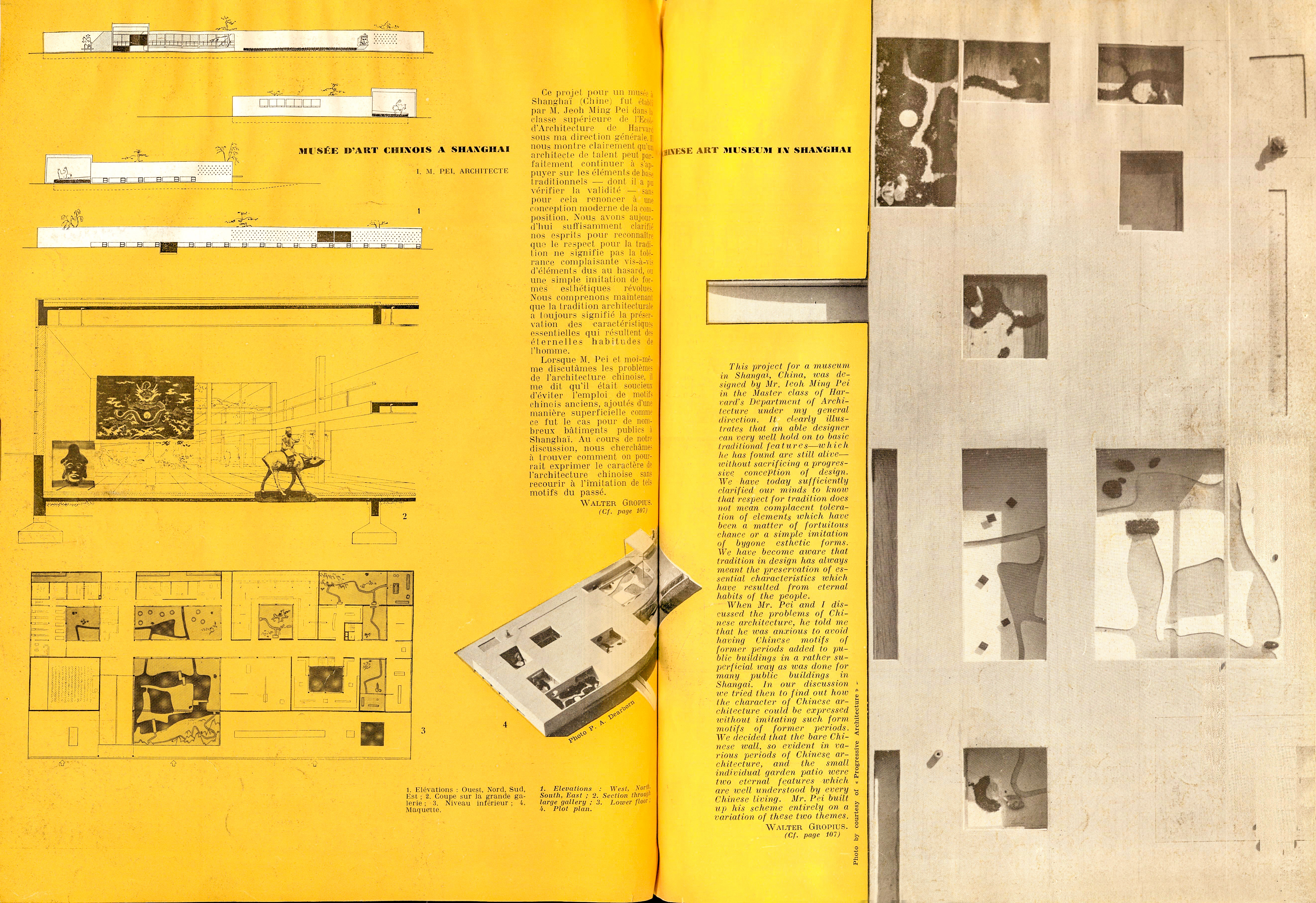
Pei’s project, titled Museum of Chinese Art for Shanghai, was memorably described by Henry Cobb (AB ’47, MArch ’49)—Pei’s longtime partner at Pei Cobb Freed & Partners and friend of more than 70 years—at a celebration of Pei’s 100th birthday held at the GSD on March 30, 2018. In explaining the significance and enduring relevance of Pei’s thesis, Cobb said that the project “was not just something he did on a whim. It was something of fundamental importance to him, which became directive of his subsequent professional life in a very real way… I doubt there’s ever been a piece of student work that was more predictive of a professional life to come than this project.”
Pei’s coursework at the GSD was interrupted by a two-and-a-half year stint with the National Defense Research Committee beginning in 1943—at the height of World War II—and the birth of his first son, T’ing Chung. He finished his degree in 1946, and in 1948 he began working for the real estate developer William Zeckendorf at Webb & Knapp in New York City. The 12 years that Pei worked for Zeckendorf undoubtedly was an extraordinary complement to his GSD education. He not only found himself designing skyscrapers and other large-scale projects, but in working for a developer he also was exposed to the kinds of financial and regulatory strategy, deal-making, and governmental stewardship that make substantial building projects possible. Taken together with the charm and urbane sophistication he was known for, it was an education that helped Pei secure competitive projects like the John F. Kennedy Presidential Library and the addition to the Louvre Museum, a project that was initially met with fierce opposition.
In 1955, Pei founded I.M. Pei & Associates (later to become I.M. Pei & Partners, then Pei Cobb Freed & Partners), and formally broke from Webb & Knapp in 1960. As the firm gradually became independent from Zeckendorf, more and more of Pei’s own architecture became realized in building projects. Kips Bay Plaza—a low-income housing project in Manhattan undertaken for Zeckendorf—was opened in 1963 and marked an advancement in the level of aesthetic consideration then thought possible within the financial constraints of low-income housing construction. The offset composition of the site plan allowed for parks and gardens for residents, echoing the pairings of galleries and offices with Chinese gardens in Pei’s thesis project.
Kips Bay is also exemplary of Pei’s intense, career-long focus on materials and his mastery of concrete. In this case, poured-in-place facades made up of grids of delicately formed, deeply recessed windows cast crisp shadows, lending residents privacy while visually softening each building’s overall magnitude. According to Pei, the use of concrete was made possible by the tenacity of Zeckendorf himself. The cost of concrete through conventional builders was too high, but Zeckendorf’s commitment to Pei’s idea drove him to extreme alternative measures: He acquired an industrial engineering company that specialized in building highways, just to keep the cost of concrete within budget. The poured-in-place facades showed up again in projects including the Society Hill Towers in Philadelphia (1964) and the Silver Towers in New York (1967).
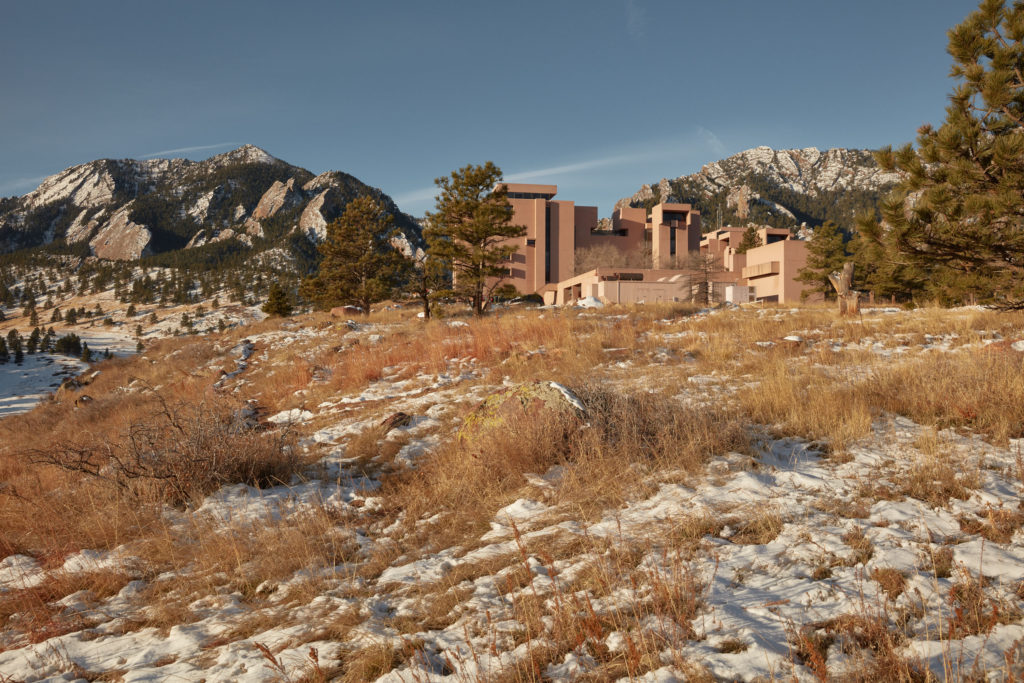
The years following saw the development of some of Pei’s most celebrated buildings. The National Center for Atmospheric Research in Boulder, Colorado, was completed in 1967 and was an important opportunity for Pei to explore the radical extent to which architecture could be integrated into its environment. Viewed from a distance, the complex all but disappears into the mountain it occupies. His first art museum in the U.S.—the Everson Museum of Art in Syracuse, New York—was completed in 1968. In his 2018 talk at the GSD, Henry Cobb noted in the building a consistency and evolution in composition and balance that, again, began with Pei’s thesis. Opened in 1968, the Everson Museum of Art put Pei on track to win important commissions for cultural institutions like the East Building of the National Gallery in Washington, which in turn led to his commission for the Louvre.
Over the course of his career, Pei designed a wide variety of buildings, many of them now essential fixtures of their cities—the Meyerson Symphony Center in Dallas (1989), the Bank of China Tower in Hong Kong (1990), and the Rock & Roll Hall of Fame in Cleveland (1995), to name a few. But he is perhaps best known for his art museums. Following the Everson Museum of Art, the East Building of the National Gallery was, at the time, Pei’s most high-profile museum commission, and also one of his most challenging sites. The building not only needed to fit a difficult trapezoid-shaped parcel of land and correspond to the museum’s original West Building, but it also needed to reflect the monumentality of the National Mall and respect the projection of federal power embodied in the geometry of its plan. Pei resolved all of these high demands with one simple, elegant stroke: dividing the trapezoid site into two triangles, one isosceles and one right triangle. The base of the isosceles triangle serves as the East Building’s entrance, and opens to face the West Building, with its midpoint located to create a continuous east-west axis across the entire museum complex. The base of the right triangle faces east to the United States Capitol building and houses administrative offices and a study center. The pairing of these two triangles was an ingenious way of integrating the building within the overdetermined context of the National Mall while also preserving its distinct identity. On the surface, such decisions reflect a sensitivity to urban design that Pei no doubt honed during his time working with Zeckendorf, but they also reveal his keen insight into the relationship between architecture and its environment that, again, can be seen germinating in his GSD thesis and evolving throughout his career.
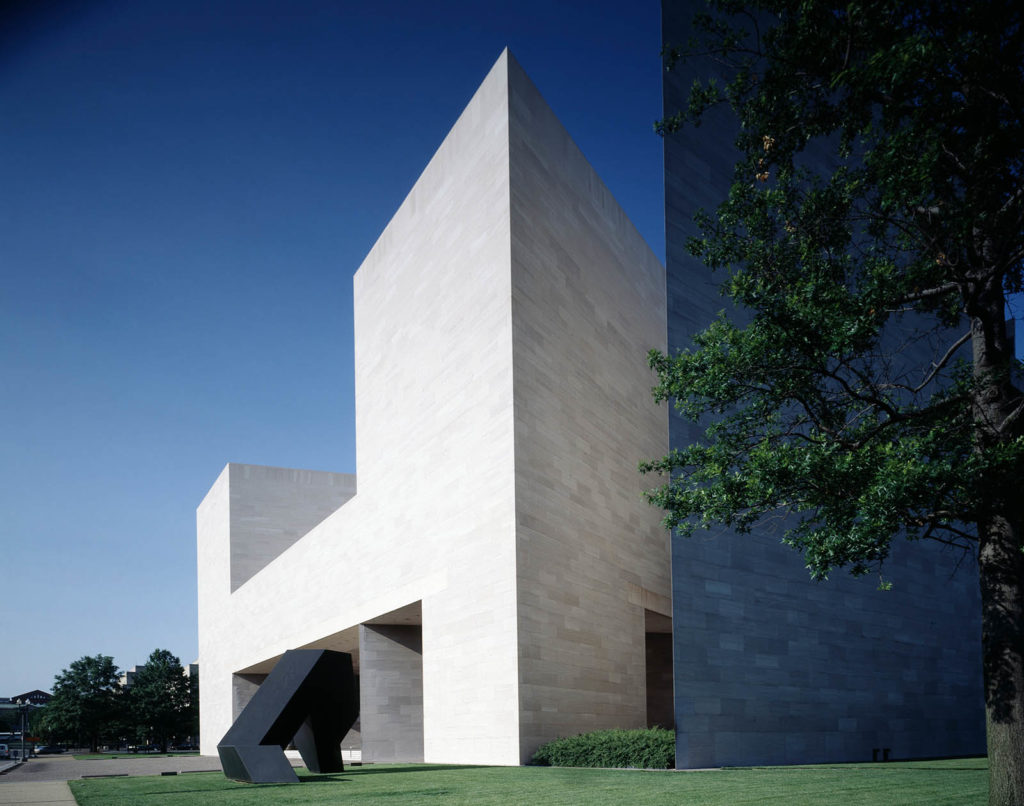
The East Building of the National Gallery was a near-unanimous critical and popular success, with the New York Times declaring the building one of the greatest of all time and Pei one of America’s best architects. In later years, Pei would go on to design other museums that earned global acclaim—the Miho Museum in Kyoto (1997) and the Museum of Islamic Art in Doha (2008), for example. His 1989 addition to the Louvre in Paris, however, will be viewed as his crowning achievement. Perhaps recognizing the daunting stakes of the project, he did not immediately agree to take it on, even after a personal entreaty from the president of France, François Mitterrand. More than 300 years earlier, French architect François Mansart had submitted at least 15 proposals to renovate the Louvre, all of which were rejected. Subsequently, at the invitation of Louis XIV, Italian architect Gian Lorenzo Bernini submitted four proposals that met the same humiliating fate. After a series of secret research trips to Paris to visit the museum, however, Pei came to believe that he should accept the commission, and he also concluded that “something must be done” about the Louvre’s dire condition.
Built in successive waves since the 12th century, originally as a fortress for soldiers and munitions, the Louvre has been adapted to accommodate a range of functions, and it presented Pei with many steep challenges: The main entrance was located along the Seine, facing south and away from the museum’s neighboring buildings and streets; the central courtyard, Cour Napoléon, was relatively neglected and being used as a parking lot for the Ministry of Finance; the serpentine floorplan was disorienting for visitors; and only 10% of the building’s square footage was dedicated to non-gallery uses like storage and administration (in the 1980s, the standard was 50%).
Much like his approach to the East Building of the National Gallery, Pei’s idea for the Louvre was at once amazingly simple and brilliant in the way it resolved a highly complex set of issues into a celebrated national icon. In excavating Cour Napoléon and adding a subterranean main entrance below the glass pyramid at its center, Pei created desperately needed space for museum staff, opened the museum to greater public access from neighboring buildings and adjacent streets on the Right Bank, and simplified navigation for visitors. He shifted the museum’s center of gravity to its central courtyard, thereby transforming what had been the inhospitable and neglected heart of the U-shaped complex into a welcoming and active public square that showcased the Louvre’s existing architecture as its backdrop.
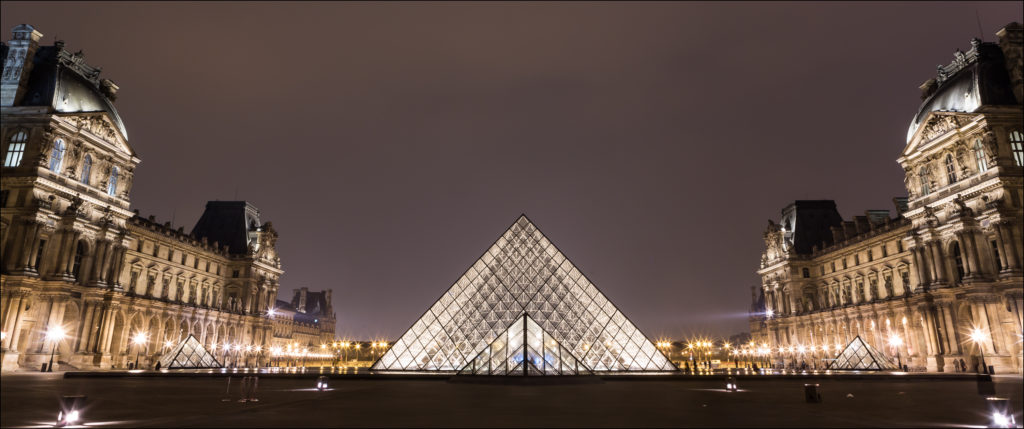
The project drew on all of Pei’s powers as an architect, urban designer, cultural sophisticate, and political tactician. His plan fully depended on—indeed, was set in motion by—President Mitterrand’s order that the Ministry of Finance, which occupied the Louvre’s northern wing (Richelieu), would be relocated elsewhere, and that the museum would expand to become the building’s sole occupant. Mitterrand’s authority to order such a drastic reorganization of the museum, however, was predicated on the consolidation of his political power, which was diminished after Jacques Chirac, leader of one of the opposition parties, was elected prime minister. Meanwhile, even though the most significant aspects of Pei’s plan would occur underground, it was the glass pyramid that became the main focus of swift and intense public outrage. The design was loudly derided as a “gigantic ruinous gadget,” an “annex to Disneyland,” and perhaps most acerbically, at least in 1980’s Paris, “a fake diamond.” The director of the museum, André Chabaud, resigned over it. When Pei unveiled the design to the Commission Supérieure des Monuments Historiques, the assault on his proposal became so intense that the translator is said to have burst into tears and withdrawn from the meeting.
Pei, however, remained undeterred and doggedly confident in the quality and logic of his plan, and rode the waves of critique while advancing his own strategy to reverse the tide of public disapproval. He hedged his good relations with President Mitterrand by cultivating a rapport with Chirac, one of Mitterrand’s leading political opponents who, prior to being elected prime minister, was mayor of Paris. As political fortunes shifted back and forth, Pei was able to steer a course forward as excavation and construction proceeded. He also was able to enlist some of France’s most prominent cultural figures to his cause: Pierre Boulez, the orchestra conductor, and Claude Pompidou, the widow of former prime minister and president Georges Pompidou, both rallied for Pei’s plan.
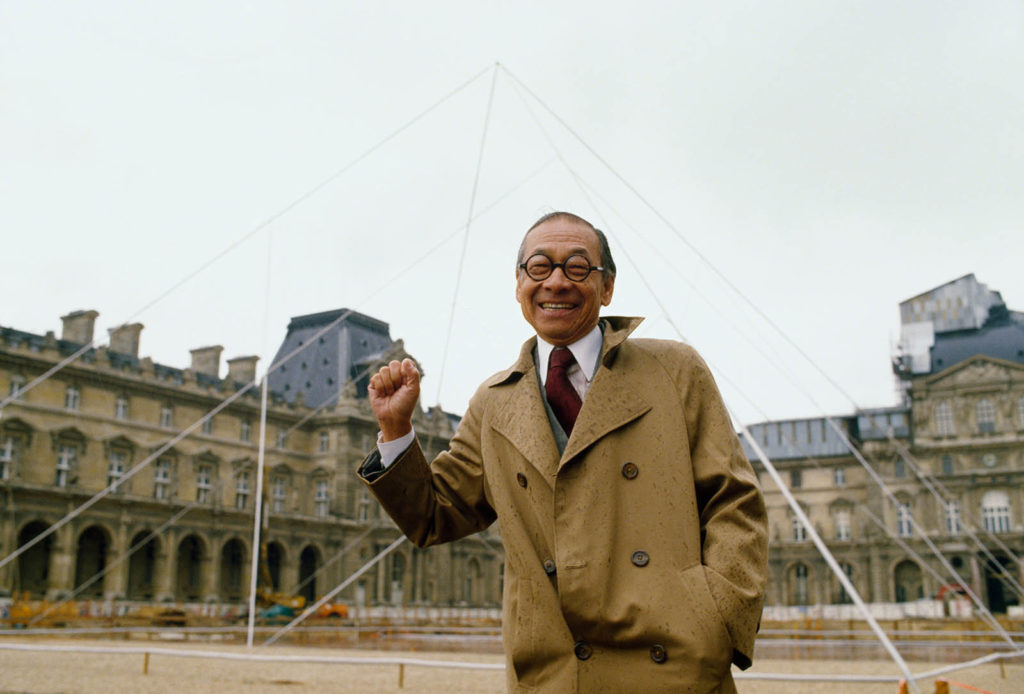
The turning point came when Chirac requested that a full-scale mock-up be prepared and shown to the public. For this, a crane was brought to Cour Napoléon to hoist cables to show the pyramid’s size and outline. The cables were left suspended from the crane for four days, during which an estimated 60,000 people visited the Louvre to see the mock-up firsthand. In response, Chirac declared the design to be “not bad”—an unequivocal gesture of approval, coming as it did from President Mitterrand’s political adversary—and praise for the project gained momentum and began spreading. Media outlets that once lambasted Pei’s proposal expressed their admiration. In March 1989, the pyramid and the new underground entrance to the museum opened to the public, making the Louvre the largest museum in the world and garnering enthusiastic international acclaim.
The Louvre will likely remain Pei’s most well-known achievement—certainly the most popular—but it also stands as the culmination of his developed sense of history and tradition and their role in modernism, the composition of space and light, and the relationship between architecture and its environment. The contrasting figure of the pyramid in particular represents a formal perfection that at once foregrounds, reflects, and disappears among the centuries-old buildings and Parisian sky that surround it. No less than the soul of France had been trusted to Pei’s hands, and he succeeded famously in elevating its history and prominence while bringing the building up to late 20th-century standards.
Ieoh Ming (I.M.) Pei, MArch ’46, was married to Eileen Loo Pei, who studied landscape architecture at the GSD. They had been married 72 years when she died in 2014. I.M. is survived by their two sons, Chien Chung (Didi) Pei, AB ’68, MArch ’72 and Li Chung (Sandi) Pei, AB ’72, MArch ’76, their daughter Liane Pei, and several grandchildren and great-grandchildren. I.M and Eileen’s eldest son, T’ing Chung Pei, AB ’65, was an urban planner and died in 2003.
